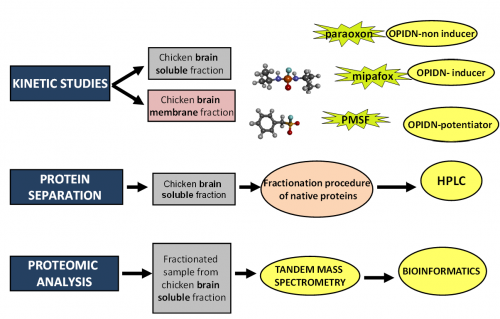Toxicology and Environmental Health Group
| Responsible | Eugenio Vilanova Gisbert |
RESEARCH SUMMARY
The group is focused on the study of molecular mechanisms of toxicity and identification of adverse effect pathways of various xenobiotics, from nanoparticles to organophosphorus compounds such as pesticides, flame retardants. The group is also active in regulatory toxicology and in the preparation of risk assessment reports on exposure to various chemicals for human health and the environment.
RESEARCH LINES
Line 1: Study of the molecular mechanisms of toxicity of various types of xenobiotics
Cellular and molecular alterations caused by xenobiotics that represent key events in the triggering of toxic responses of the target systems of these xenobiotics are studied. Molecular biology, biochemical and omics techniques are used.

Titanium oxide nanoparticles inside a T98G human glioblastoma cell.
Line 2: Development of alternative methods to animal experimentation for the evaluation of neurotoxicity and embryonic developmental toxicity of xenobiotics.
Molecular markers of xenobiotic exposure effects are identified in cell cultures of nerve cells and embryonic stem cells. These biomarkers are used to develop methods to predict the adverse effects of xenobiotics.

Schematic of an alternative procedure to animal experimentation to predict the embryotoxic potential of xenobiotics. Taken from Romero et al., Toxicology Letters 2015; 238:60-69.
Línea 3: Identification of novel molecular targets of organophosphate toxicity
Identification of carboxylesterases susceptible to be new targets of neurotoxicity of organophosphorus compounds in birds and mammals. Proteomic and biochemical techniques are used.

Schematic of the procedure used in the identification of neurotoxicity targets in birds.
Line 4: Molecular mechanisms of interaction of substrates and inhibitors with cholinesterases
The molecular mechanisms of the interaction of various substrates and inhibitors with cholinesterases are studied, especially with acetylcholinesterase, an enzyme responsible for regulating the neurotransmitter acetylcholine.

Schematic of the spontaneous reactivation assay of acetylcholinesterase activities after inhibition with paraoxon.
M. Luconi, M.A. Sogorb, U.R. Markert, E. Benfenati, T. May, S. Wolbank, A. Roncaglioni, A. Schmidt, M. Straccia, S. Tait
Int. J. Environ. Res. Public Health 19, 15828 (2022).
C. Estevan, E Vilanova, M.A. Sogorb
Case study: risk associated to wearing silver or graphene nanoparticle-coated facemasks for protection against COVID-19
Arch Toxicol 96(1):105-119 (2022).
E Fuster, H Candela, J Estévez, E Vilanova, M.A. Sogorb
A Transcriptomic Analysis of T98G Human Glioblastoma Cells after Exposure to Cadmium-Selenium Quantum Dots Mainly Reveals Alterations in Neuroinflammation Processes and Hypothalamus Regulation.
Int J Mol Sci. 23(4):2267 (2022).
J. Estévez, M. Terol, M.A. Sogorb, E. Vilanova.
Interactions of human acetylcholinesterase with phenyl valerate and acetylthiocholine: Thiocholine as an enhancer of phenyl valerate esterase activity.
Int J Mol Sci. 23(4):2267 (2022).
E. Fuster, H. Candela, J. Estévez, E. Vilanova, M.A. Sogorb
Titanium Dioxide, but Not Zinc Oxide, Nanoparticles Cause Severe Transcriptomic Alterations in T98G Human Glioblastoma Cells.
International Journal of Molecular Sciences 22, 2084 (2021).
E. Fuster, H. Candela, J. Estévez, A.J. Arias, E. Vilanova, M.A. Sogorb
Effects of silver nanoparticles on T98G human glioblastoma cells.
Toxicology Applied Pharmacolgy, 404:115178 (2020).
M.A. Sogorb, J. Estévez, E. Vilanova
Case study: Is bisphenol S safer than bisphenol A in thermal papers?
Archives of Toxicology 93:1835-1852 (2019).
M. Faria, I. Fuertes, E. Prats, JL. Abad, F. Padrós, C. Gómez-Canela, J. Casas, J. Estévez, E. Vilanova, B. Piña, D. Raldúa.
Analysis of the neurotoxic effects of neuropathic organophosphorus compounds in adult zebrafish.
Scientific Reports 8(1):4844 (2018).
M. González-González, J. Estévez, E. Del Río, E. Vilanova, M.A. Sogorb
Hydrolyzing activities of phenyl valerate sensitive to organophosphorus compounds paraoxon and mipafox in human neuroblastoma SH-SY5Y cells.
Toxicology 406-407:123-128 (2018).
Hacia un nuevo paradigma en la identificación de peligros y evaluación de la seguridad y el riesgo de neurotoxicidad asociado la exposición a nanomateriales con aplicaciones biotecnológicas. Funding agency: Fundación Ramón Areces. Duration: 2017-2019.
PI: Miguel A. Sogorb
| Name | Activities |
|---|---|
| Eugenio Vilanova | Honorary Member de EUROTOX |
| Miguel Ángel Sogorb | Member of the Risk Assessment Committee of the European Chemicals Agency. |
The members of the group have actively collaborated with the Ministry of Health in the preparation of biocide registration dossiers.
